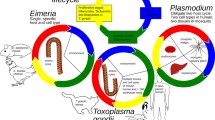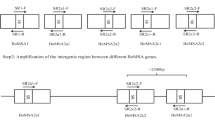Abstract
Encephalitozoon cuniculi and E. hellem are often recognized as the agents of human microsporidiosis, but less than optimal therapy is available for treatment. The identification of enzymes critical to the parasitic life cycle is an important step in finding targets for potential drug development. Aminopeptidase gene sequences were obtained from cDNA and gDNA from avian and human E. hellem isolates and from a rabbit E. cuniculi isolate. At the amino acid level, the aminopeptidase sequences from the E. hellem human and bird isolates share >99% identity and are nearly 70% identical with the E. cuniculi sequence. Conserved HEXXH and GAMEN motifs classify the predicted aminopeptidase in the MA clan of the M1 family. The obtained aminopeptidase gene sequences are likely homologous to the previously reported E. cuniculi glutamyl aminopeptidase. The conservation of this aminopeptidase between species and divergence from mammalian aminopeptidases indicate that this enzyme may be a valid target for drug therapy.



Similar content being viewed by others
References
Allary M, Schrevel J, Florent I (2002) Properties, stage-dependent expression and localization of Plasmodium falciparum M1 family zinc-aminopeptidase. Parasitology 125:1–10
Altschul SF, Gish W, Miller W, Myers EW, Lipman DJ (1990) Basic local alignment search tool. J Mol Biol 215:403–410
Barton CE, Phalen DN, Snowden K (2003) Prevalence of microsporidian spores shed by asymptomatic lovebirds: evidence for a potential emerging zoonosis. J Avian Med Surg 17:197–202
Canny CJ, Ward DA, Patton S, Orosz SE (1999) Microsporidian keratoconjunctivitis in a double yellow-headed Amazon parrot (Amazona ochrocephala oratrix). J Avian Med Surg 13:279–286
Costa SF, Weiss LM (2000) Drug treatment of microsporidiosis. Drug Resist Updates 3:384–399
Didier ES, Didier PJ, Friedberg DN, Stenson SM, Orenstein JM, Yee RW, Tio FO, Davis RM, Vossbrinck C, Millichamp N (1991) Isolation and characterization of a new human microsporidian, Encephalitozoon hellem (n.sp.), from three AIDS patients with keratoconjunctivitis. J Infect Dis 163:617–621
Didier ES, Visvesvara GS, Baker MD, Rogers LB, Bertucci DC, De Groote MA, Vossbrinck CR (1996) A microsporidian isolated from an AIDS patient corresponds to Encephalitozoon cuniculi III, originally isolated from domestic dogs. J Clin Microbiol 34:2835–2837
Florent I, Derhy Z, Allary M, Monsigny M, Mayer R, Schrevel J (1998) A Plasmodium falciparum aminopeptidase gene belonging to the M1 family of zinc-metallopeptidases is expressed in erythrocytic stages. Mol Biochem Parasitol 97:49–160
Fournier S, Liguory O, Sarfati C, David-Ouaknine F, Derouin F, Decazes JM, Molina JM (2000) Disseminated infection due to Encephalitozoon cuniculi in a patient with AIDS: case report and review. HIV Med 1:55–161
Katinka MD, Duprat S, Cornillot E, Metenier G, Thomarat F, Prensier G, Barbe V, Peyretaillade E, Brottier P, Wincker P, Delbac F, El Alaoui H, Peyret P, Saurin W, Gouy M, Weissenbach J, Vivares CP (2001) Genome sequence and gene compaction of the eukaryote parasite Encephalitozoon cuniculi. Nature 414:450–453
Kemp RL, Kluge JP (1975) Encephalitozoon sp. in the blue-masked lovebird, Agapornis personata (Reichenow): first confirmed report of microsporidan infection in birds. J Protozool 22:489–491
Klemba M, Goldberg DE (2002) Biological roles of proteases in parasitic protozoa. Annu Rev Biochem 71:275–305
Kotler DP, Orenstein JM (2000) Clinical syndromes associated with microsporidiosis. In: Wittner M, Weiss LM (eds) The microsporidia and microsporidiosis. ASM, Washington, pp 258–292
Mathis A (2000) Microsporidia: emerging advances in understanding the basic biology of these unique organisms. Int J Parasitol 30:795–804
McKerrow JH (1999) Development of cysteine protease inhibitors as chemotherapy for parasitic diseases: insights on safety, target validation, and mechanism of action. Int J Parasitol 29:833–837
Millership JJ, Didier ES, Okhuysen PC, Maddry JA, Kwong CD, Chen X, Snowden KF (2001) In vitro and in vivo evaluation of aminopeptidase inhibitors as antimicrosporidial therapies. J Eukaryot Microbiol Suppl:95S-98S
Millership JJ, Chappell CL, Okhuysen PC, Snowden KF (2002a) Characterization of a cytosolic aminopeptidase from Encephalitozoon intestinalis. Parasitology 124:1–7
Millership JJ, Chappell C, Okhuysen PC, Snowden KF (2002b) Characterization of aminopeptidase activity from three species of microsporidia: Encephalitozoon cuniculi, Encephalitozoon hellem, and Vittaforma corneae. J Parasitol 88:843–848
Novilla MN, Kwapien RP (1978) Microsporidian infection in the pied peach-faced lovebird (Agapornis roseicollis). Avian Dis 22:198–204
Poonacha KB, William PD, Stamper RD (1985) Encephalitozoonosis in a parrot. J Am Vet Med Assoc 186:700–702
Rawlings ND, Barrett AJ (1995) Evolutionary families of metallopeptidases. In: Barrett AJ (ed) Methods in enzymology, proteolytic enzymes: aspartic and metallopeptidases. Academic Press, San Diego, pp 183–228
Shadduck JA (1969) Nosema cuniculi: in vitro isolation. Science 166:516–517
Snowden KF, Logan K, Phalen DN (2000) Isolation and characterization of an avian isolate of Encephalitozoon hellem. Parasitology 121:9–14
Weiss LM, Vossbrinck CR (1999) Molecular biology, molecular phylogeny, and molecular diagnostic approaches to the microsporidia. In: Wittner M, Weiss LM (eds) The microsporidia and microsporidiosis. ASM, Washington, D.C., pp 129–171
Acknowledgements
The authors thank Kathleen Logan and Douglas Melendy for excellent technical assistance. This investigation was supported by the Schubot Exotic Bird Health Center, Texas A&M University, and Texas Agricultural Experiment Station Project H6261. All experiments were conducted in compliance with the laws of the countries in which they were performed.
Author information
Authors and Affiliations
Corresponding author
Rights and permissions
About this article
Cite this article
Waters, P.F., Snowden, K.F. & Holman, P.J. A comparison of homologous genes encoding aminopeptidases among bird and human Encephalitozoon hellem isolates and a rabbit E. cuniculi isolate. Parasitol Res 93, 410–418 (2004). https://doi.org/10.1007/s00436-004-1148-y
Received:
Accepted:
Published:
Issue Date:
DOI: https://doi.org/10.1007/s00436-004-1148-y




